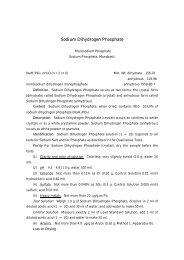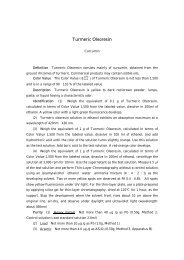Specific Gravity
Specific Gravity
Specific Gravity
You also want an ePaper? Increase the reach of your titles
YUMPU automatically turns print PDFs into web optimized ePapers that Google loves.
B. GENERAL TESTS<strong>Specific</strong> <strong>Gravity</strong><strong>Specific</strong> <strong>Gravity</strong> means the ratio of the mass of a sample to that of an equalvolume of a standard substance. In this test, the specific gravity ( d )t t' means theratio of the weight of the sample at t' to that of an equal volume of distilled waterat t. When the specific gravity only is given, unless otherwise specified, it means20the ratio of the weight ( )d of the sample at 20 to that of an equal volume of20distilled water at 20. Unless otherwise specified, the measurement is performed byMethod 1, Method 2, or Method 4. When the figure specified is accompanied with"about," Method 3 is also applicable.Method 1. Measurement by Pycnometer A pycnometer is a bottle with acapacity of usually 10 ml to 100 ml, having a ground-glass stopper fitted with athermometer, and a side inlet-tube with a marked line and a ground-glass cap.Weigh accurately a pycnometer, previously cleaned and dried, and note theweight W. Remove the stopper and the cap, fill the pycnometer with the sample,keeping at a temperature 13 lower than the specified temperature (t'), andstopper, preventing bubble formation. Raise the temperature gradually, when thethermometer shows the specified temperature, remove the portion of the sampleabove the mark from the side tube, and stopper the side tube. Wipe the outsidesurface thoroughly, weigh accurately, and note the weight W 1 . Perform the sameprocedure, using the same pycnometer containing distilled water, note the weight W 2t'at the specified temperature (t). Calculate the specific gravity ( )d by the formulatMethod 2. Measurement by Sprengel-Ostwald Pycnometer The Sprengel-Ostwald pycnometer (Figure) usually has a capacity of 1 to 10 ml, with thick-walledfine tubes at both ends. On one of the fine tube (A), there is a marked line (C). Whenweighing, attach platinum wire (or aluminum wire, etc.) D so that the pycnometer ishung with the wire on the hook of the chemical balance.Weigh accurately the pycnometer, previously cleaned and dried, and note weightW. Immerse fine tube B without marked line in the sample kept at a temperature 35 lower than the specified temperature. Attach a rubber tube or a ground-glasstube to the end of A, and gently suck up the sample until the forefront comes upabove marked line C, preventing bubble formation. Immerse the pycnometer in a
B. GENERAL TESTSwater bath kept at the specified temperature (t') for 15 minutes, and then, byattaching a piece of filter paper to the end of B, adjust the front of the sample tomarked line C. After taking the pycnometer out of the water bath and wiping itsoutside well, weigh accurately its weight (W 1 ). By use of the same pycnometer,perform the same determination with distilled water. Weigh accurately thepycnometer containing distilled water at the specified temperature (t), and notet'weight W 2 . Calculate the specific gravity ( )d by the formulatMethod 3. Measurement by Hydrometer Use a hydrometer for the specifiedtemperature with the required precision. Before using, clean with ethanol or ether.Shake the sample well. After the bubbles disappear, place the hydrometer in thesample. When the hydrometer comes to a standstill at the specified temperature,read the specific gravity at the upper brim of the meniscus. When using a hydrometerwith specific instructions, make a reading in accordance with the instruction.Method 4. Measurement by Oscillator-Type Density MeterMeasurement with an oscillator-type density meter is designed to determinethe specific gravity of a liquid or gaseous sample from the density of the sampleobtained by measuring the intrinsic vibration period (T (s)), of a cell filled withthe sample. The specific gravity is determined from the mass of referencesubstances. When a cell containing a sample is vibrated, it undergoes avibration with an intrinsic vibration period (T) in proportion to the mass of thesample. If the volume of the vibrating part of the sample cell is fixed, the relationof the square of intrinsic oscillation period and density of the sample shall be
B. GENERAL TESTSlinear. Before measuring a sample density, the respective intrinsic oscillationperiods, Tsl and Ts2, for two reference substances (density:s1,s2) must bemeasured at a specified temperature (t' ), and the cell constant Kt' (g•cm –3 s –2 )must be determined by the formula t’ s1 ’ s2Kt' = T 2 sl T 2 s2Usually, water and dried air are used as reference substances. Here the densityof water at t'C, t’ s1, is obtained from the attached table, and that of dried air ’ s2is calculated by the formula ’ s2 = 0.0012932 {273.15/(273.15t’) }(p/101.325),where the pressure of dried air is at p kPa.Next, introduce the sample into a sample cell of a cell constant ( Kt') and measurethe intrinsic vibration period(TT) of the sample under the same operating conditionsas used for the reference substances. Then, determine the density of the sample (’ T ) using the intrinsic oscillation period(Tsl) and the density of water( t’ s1) at aspecified temperatute (t'C) by the formula ’ T = t’ s1 Kt' ( T T 2 sl).Then, determine the specific gravity of a sample(d t ’t) against water at atemperature (tC) using the density of water ( t s1) at a temperature (tC) indicatedin the table by the formulad t ’t = t’ T / t s1 .Apparatus An oscillator-type density meter is usually composed of a U-shapedglass tube cell of about 1 ml volume, the end of which is fixed to the vibration plate,an oscillator which applies an initial vibration to the cell, a detector to measuring theintrinsic vibration period, and a temperature controlling system. The apparatus isillustrated in the figure.A : ThermometerB : Sample cellC : Vibration plateD : AmplifierE : DetectorF : Vibrator
B. GENERAL TESTSProcedureAdjust previously the sample cell, water, and the sample to a specifiedtemperature (t'C). Wash the sample cell with water or an appropriate solvent, anddry it thoroughly with a flow of dried air. Stop the flow of dried air, confirm that thetemperature is at the specified value, and then measure the intrinsic oscillationperiod TS2 given by the dried air. Separately, measure the atmospheric pressure (pkPa) at the place of determination. Next, introduce water into the sample cell andmeasure the intrinsic oscillation period (Tsl) for water. Determine the cell constant(Kt') of the sample, using the intrinsic oscillation period and the atmospheric pressurefor each of water and dried air by above-mentioned formula.Next, introduce a sample into the glass cell, confirm that the specifiedtemperature is kept, and measure the intrinsic oscillation period TT for the sample.Obtain the density of the sample( t' T), using the intrinsic oscillation periods forwater and the sample, the density of water ( t' s1), and the cell constant (Kt'). Ifnecessary, calculate the specific gravity of the sample (d t 't) against water at atemperature (tC), using the density of water ( t S1) given in the table above.In this measurement, avoid the occurrence of bubble formation in the samplecell, when introducing the sample or water into the cell.TemperatureDensityg/cm 3TemperatureDensityg/cm 3TemperatureDensityg/cm 3TemperatureDensityg/cm 301234567890.999840.999900.999940.999960.999970.999960.999940.999900.999850.99978101112131415161718190.999700.999610.999500.999380.999240.999100.998940.998770.998600.99841202122232425262728290.998200.997990.997770.997540.997300.997040.996780.996510.996230.99594303132333435363738390.995650.995340.995030.994700.994370.994030.993680.993330.992970.99259
















